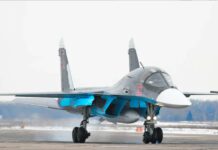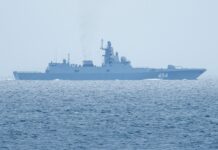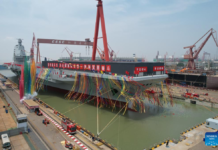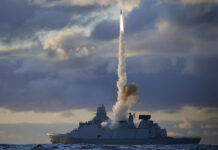On 8 July 2022, BELGOROD, the world’s largest submarine, was handed over to the Russian Navy. The ceremonial signing of the acceptance protocol and handover, where St. Andrew’s flag is hoisted in accordance with Russian procedure, took place at the Sevmash shipyard in the Nikolskoye estuary near Severodvinsk. According to a press release from the shipyard, the leadership of the Ministry of Defence, the Navy, the administrations of Arkhangelsk and Severodvinsk oblasts and representatives of the shipbuilding industry were present.
Background to the BELGOROD
Already laid down in 1992, it took twenty years until the unit could be delivered. In 2000, after the disaster with the predecessor boat K-141 KURSK, construction was interrupted for more than a decade. The christening of the shipyard-built number 664 took place on 23 April 2019. At 184 metres in length and with a displacement of 30,000 tonnes (submerged), K-329 BELGOROD overshadows other Russian TYPHOON-class nuclear submarines (SSBN/SSGN) as well as the US Navy’s OHIO class.
Together with her two intended sister ships, she actually belongs to the third generation of Russian nuclear submarines. Of these 11 ships built between 1982 and 1996, eight are still in service, two were scrapped. K-141 KURSK sank in the Barents Sea in August 2000. As the twelfth ship of this type of submarines (SSGN) designed for cruise missile use, K-329 was revived for a new purpose with a modified design. It was continued in December 2012 as project 09852 and transformed into a “special research and rescue submarine” or multifunctional submarine.
Mothership
The hull of K-329 BELGOROD was expanded to include a dock for small Unmanned Underwater Vehicles (UUV) and submarine rescue vehicles. Thus, the former attack submarine will be used as a nuclear-powered mother ship for up to eight underwater drones. It is to deploy underwater equipment and carry out cable laying or inspections. For this purpose, it can piggyback smaller (autonomous) underwater vehicles or even take accommodate them inside the hull. The HARPSICHORD 2P-PM autonomous underwater vehicle can be docked to the ship’s belly. There is also a station for carrying submarines up to 70 m in length (relevant circles mention projects 18511 and 10831 LOSHARIK, both of which can be deployed at diving depths of up to 1,000 m and are equipped with multiple robotic arms and nuclear-powered deep-sea submersibles reminiscent in appearance of the Russian KILO class).
Furthermore, BELGOROD will become the carrier for the new POSEIDON underwater drone system announced by Vladimir Putin in his State of the Union address on 1 March 2018.
POSEIDON Details
With an “intercontinental” range of almost 10,000 km at a top speed of about 100 km/h (54 knots), POSEIDON is capable of delivering its cargo to the target over very long distances. Based on previously leaked technical drawings and analysis of some test images released by the Russian Ministry of Defence, POSEIDON measures about 24 m in length and 1.6 m in diameter. The sketches show a warhead about 4 m length with a diameter of 1.5 m. The explosive power figures range from 2 to 100 megatons. BELGOROD is supposed to have six such POSEIDONs. To what extent a reloading is possible (which would require (a) further charge(s)) is not known. Russian media such as TASS and RIA like to refer to secrecy in this context.
Other Features
In addition to the deployment of POSEIDON, reconnaissance will be a significant part of the tasks of BELGOROD and her two sister ships. The sketches circulating show a towed array sonar. In addition, HARMONY will probably be used, a sensor network for submarine detection that the Russian military wants to station in the Arctic – similar to the US Navy’s SOSUS sonar network. BELGOROD will be able to use its equipment, including the UUV, to place sensors powered by underwater nuclear generators. Images also show some kind of towing equipment, presumably to lay underwater cables. Also visible are places that suggest the use of jet propellers to allow the boat to manoeuvre in tight conditions, or to hold it in position for precision work. The diving depth is said to be about 520 m (1,700 feet).
As with the other reconnaissance vessels, command and operational deployment are to be carried out by Glavnoye Upravlenie Glubokovodsk Issledovanii (GUGI). This is the largely secretive main department for underwater research within the Naval Command Staff at the Ministry of Defence. Because of its strategic importance, it is conceivable that the operational command of BELGOROD lies directly in the Kremlin (with the President).
Viability
With BELGOROD and POSEIDON as its main armament, Moscow hopes to strengthen its second-strike capacity. Possible targets of the high-performance torpedo are carrier groups and coastal infrastructure. In March 2018, Putin informed the Russian and world public about his plans to strengthen Russia’s military response capabilities. This was in response to American deployment plans in Poland and Romania. In the process, he had several videos shown of new types of weapon systems – including POSEIDON. A Russian Defence Ministry spokesperson confirmed to journalists in March 2019 that tests with Poseidon had been successfully completed. He added that the training of the carrier vehicle’s personnel had been completed. Crew strength is said to be 25.
A portion of scepticism remains about both the overall project and the super torpedo. Among the considerable challenges will be the deprivation from enemy reconnaissance of such a large weapon system. Also, the requirements for command and control, especially in the case of such a long-range torpedo with nuclear potential, are of elementary importance, because one might want to abort the attack or change the target. Its devastating effect when used near the coast is worrying. In addition to the direct hit effects, secondary effects from tsunamis are conceivable – Fukushima comes to mind here.
Doctrine
Russia is opening a new chapter in naval warfare with its submarine mother ship BELGOROD. Technological advantages no longer speak in favour of submarines to the same extent as before. Added to this are advances in anti-submarine warfare techniques and methods. The use of big data, the consolidation of a variety of sensors that, to take just one example, are able to detect the radiation released by submarine reactors, require new approaches. At the same time, it is becoming more expensive to make submarines quieter or better camouflaged. Submarines that can linger in the depths or even close to the seabed and operate there can evade detection. If weapons could even be deployed, for example by POSEIDON, traditional maritime warfare under water would experience a paradigm shift. So would the principle of nuclear deterrence. Ultimately, such a weapon would also open a new chapter in the nuclear arms control regime.
Originally, BELGOROD was to be handed over to the fleet in 2020. TASS notes that the COVID 19 pandemic is said to be the cause of the delays. According to Russian sources, BELGOROD is to be assigned to the Northern Fleet, as is the sister ship, project 09853. Construction number 2, KHABAROVSK, project 09851, is to go to the Pacific Fleet. Her arrival is expected in 2024, that of her sister ship in 2025.












